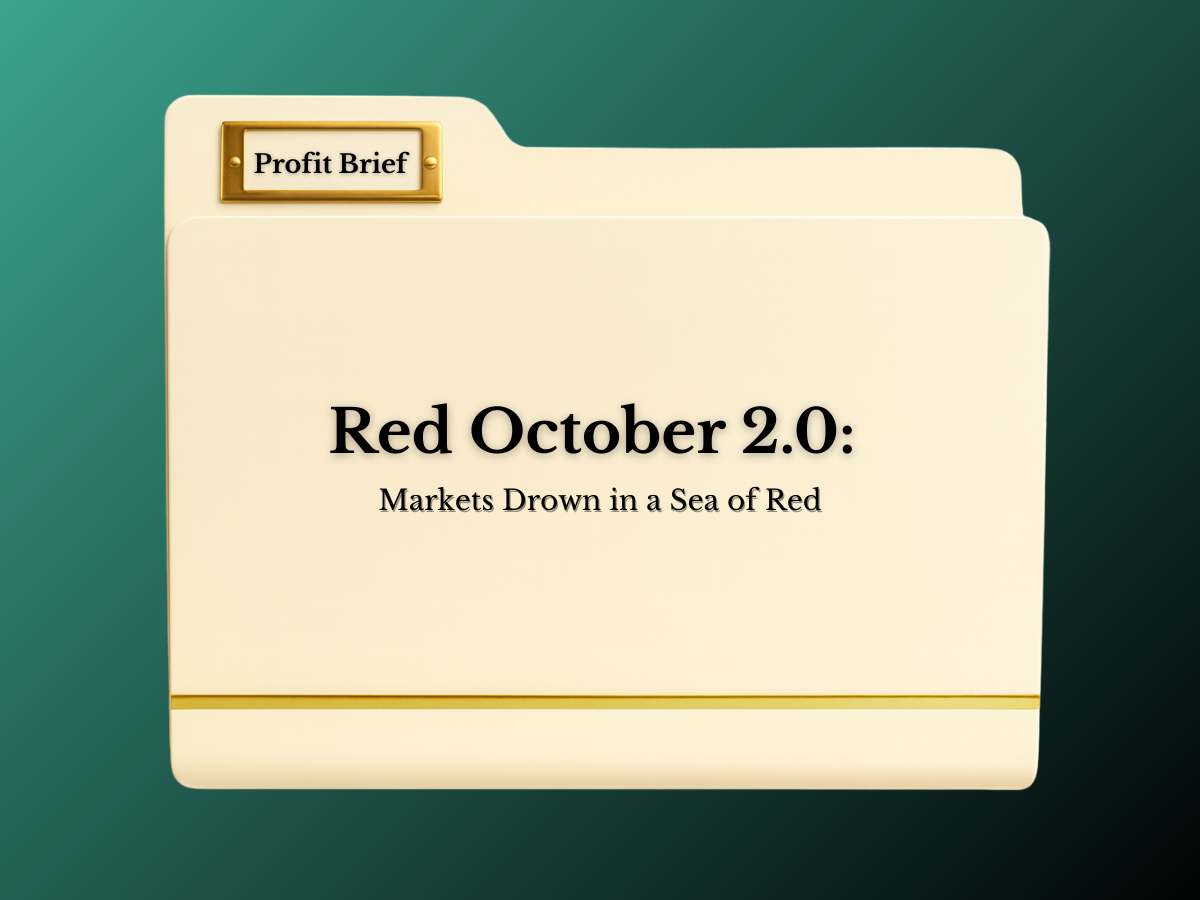
Man Who Called Nvidia at $1.10 Says Buy This Now...
This company signed a major deal with Apple
Nvidia has invested more in this one company than any othe
And its tech is found in products from Samsung and Google

Welcome to The Profit Zone 👋
Where thousands of millionaires, CEO’s and high-performing entrepreneurs read the #1 financial newsletter on the web.


👉 Stock Market Looks Risky For 2025: Should You Be Concerned? 🤷
👉 The Right Way to Becoming Debt Free Forever: 2 Proven Strategies 🏔
👉 The Profit Academy: Premium Just Got Better 📈


“A 10% decline in the market is fairly common—it happens about once a year. Investors who realize this are less likely to sell in a panic, and more likely to remain invested, benefitting from the wealth building power of stocks.”


The Stock Market Poses A Risk Going Into 2025 - Should You Be Concerned?

Millions of investors saw their net worth rise since the pandemic, powered by astronomic gains in the stock market.
This has been the strongest back to back years of gains since the Clinton years in the late 1990s.
But now there are growing concerns that things may be getting out of hand, and the price tag on some stocks have overextended past normal levels.
The Nasdaq, powered by the artificial intelligence boom and the Magnificent Seven group of tech stocks, surged 29% last year, building on the eye-popping advance of 43% in 2023.
Mark Zandi, chief economist at Moody’s Analytics, told CNN that if investors saw their portfolios drop in value, confidence in the stock market would take a hit and it would erode both the willingness and ability to spend.
DD’s Take: If you’ve been following along, we’ve set up our portfolio in a way that invites a market decline. Our margin of safety continues with ETFs and high quality dividend stocks with consecutive years of dividend increases. If the market were to experience a 20%+ decline, the cash flow generated from our portfolio would help offset some of the loses while also using that to buy into existing positions that have fallen and lower our average cost.



The median salary in America is $59,228 per year.
The average American has $90,460 in debt.
That’s a problem.
Here’s how much debt Americans have at every age…
Gen Z (ages 18 to 23): $9,593
Millennials (ages 24 to 39): $78,396
Gen X (ages 40 to 55): $135,841
Baby boomers (ages 56 to 74): $96,984
Silent generation (ages 75 and above): $40,925
Source: CNBC
How do you stack up?
Consumer debt can be crippling to your financial goals.
Which is why I’m giving you 2 proven methods to escape debt, so you can then focus on building a secure financial future for yourself and your loved ones.
But first, you must understand what debt is…
Simply put, debt means borrowing money from a person or bank that you have to pay back later.
It almost always comes with a fee.
Credit providers charge a certain amount on the borrowed money. This is what we call “interest”.
For example, you want to buy a $2,000 car, but you only have $1,500. You ask your friend for the missing $500, and you both agree on 10% interest meaning you have to pay him back $550 when it’s all set and done.
Now that you understand what debt is, let’s dive into the 4 types of debt.
The 4 types of debt:
Secured debt: When you borrow money from a bank, they ask you to give them something valuable in return, like your house or car, as a guarantee. If you fail to pay your debt, the bank will sell your guarantee to get its money back.
Unsecured debt: If you can't (or don’t want to) offer something valuable as a guarantee, the bank has another way to decide if they should lend you money. They will look at your credit score, which shows how good you are at repaying debts on time. This way, they can still give you money, but usually less than they would if you had offered something valuable as a guarantee. Credit cards, car loans, and student loans are examples of unsecured debt.
Revolving debt: Just like a revolving door, revolving credit allows you to keep using the money you borrowed, as long as you pay it back. Credit cards are a great example of this type of debt. When you get a credit card, the bank gives you a set amount of money that you can spend. You must pay back the bank later, but once you do, you can reuse your credit card’s available credit limit.
Mortgage: When you borrow money to buy a house, the bank will use the house as a guarantee. The bank still wants to make sure you're good at repaying debts, so they check your credit score first. Failing to repay the mortgage results in the bank taking your new house away from you.
As with everything in life, debt has advantages and disadvantages too. So here are some good things about debt:
It can help you make big purchases
It can open up new opportunities like student loans
It can decrease your tax obligation
It is a legal and convenient way of financing
But, there are also some bad things about debt that will keep you living paycheck-to-paycheck:
It can increase the lack of financial resources
It comes with interest which can add up to a lot of money
If you have secured debt, you could lose your personal assets
Now, if you have debt and want to get rid of it, these 2 proven methods have helped 98% of my students (That's because the other 2% percent didn't read the whole email).

The Snowball Method.
Focus on paying off your smallest debts first, regardless of interest rates. This way, you have more money to tackle larger debts, like your car loan or big credit card balance. Like a snowball, you'll quickly progress from small to big, and with time, paying your higher debts will be much easier.
The Avalanche Method.
Focus on paying off your highest interest rate first, no matter how much you owe. This will save you money on interest that you can use to pay off your debts faster. The goal is to get out of debt as soon as possible. Paying off a debt with no interest while having another debt charging high interest will lose you money in the long run.
The truth is, it doesn’t matter which method you choose to pay off debt because they both have the same core principle.
Pick one debt, focus on it, and pay as much as you can each month until it's paid off, while still making the minimum payments on your other debts.
Keep in mind that it's better to pay off your debts bit by bit instead of giving up or sinking into the hole.
Pick the method you like more and stick to it.
Nobody is going to hold your hand.
Come up with a plan and execute it.
Investing becomes so much more enjoyable (and effective) when you don’t owe anyone else money.
This is because debt amplifies your emotional response to losses. If you’re investing in the stock market, and the value of your portfolio drops by 20%, but you have mountains of debt to pay off, you may be more inclined to panic sell to get yourself out of a worse situation.
When you don’t have debt and you also have extra liquidity, the fall in the market could be a perfect buying opportunity to build long term wealth.
The peace of mind of not having debt is priceless.
Did you know you can see exactly what stocks Warren Buffett is buying?
Billionaires are required to disclose what investments they are making.
I’ll show you how to find that information.
Step 1: go to www.dataroma.com
Step 2: click on the “Superinvestors” tab at the top of the page

Step 3: Control + Find for “Warren Buffett” or anyone else you want to spy on
Step 4: Click on their name and view their portfolio
Here’s a quick look at some of Buffett’s portfolio and activity as of September 30, 2024.





Did you enjoy this newsletter?


We’ve taken premium to a whole new level
Previously our premium members were getting bi-weekly newsletters with access to our 2024 stock picks.
Every issue provided updates on the stock performance, with deep dives on valuations and earnings reports.
We gave BUY or SELL signals and managed to return 41% in 6 months beating the market in 92% of periods.
That calls for a celebration 🎉
But we just released something new…
Since then, we’ve added a new feature to our premium membership, only making this membership more valuable to you.
Introducing The Profit Academy, a community of investors all on the same path towards financial freedom.
I launched this community with one goal in mind: to give you more direct access to my way of thinking, my portfolio, my watchlists and to provide updates on my buys and sells in real time.
When you upgrade to premium for less than what you’ll spend on lunch today, you get immediate access.
The community is being filled with valuable content every single day and continues to get better.
If you’re already a premium member, this comes at no additional cost to you.
If you’re not a premium member, get in now before the prices go up in 2025.
Here’s a little sneak peak of what you can expect inside:

P.S. There’s a 14-day free trial. Pay $0 today and test the waters.
See you inside!

Disclaimer: The publisher does not guarantee the accuracy or completeness of the information provided in this page. All statements and expressions herein are the sole opinion of the author or paid advertiser.
Dividend Domination Inc. is a publisher of financial information, not an investment advisor. We do not provide personalized or individualized investment advice or information that is tailored to the needs of any particular recipient.
THE INFORMATION CONTAINED ON THIS WEBSITE IS NOT AND SHOULD NOT BE CONSTRUED AS INVESTMENT ADVICE, AND DOES NOT PURPORT TO BE AND DOES NOT EXPRESS ANY OPINION AS TO THE PRICE AT WHICH THE SECURITIES OF ANY COMPANY MAY TRADE AT ANY TIME. THE INFORMATION AND OPINIONS PROVIDED HEREIN SHOULD NOT BE TAKEN AS SPECIFIC ADVICE ON THE MERITS OF ANY INVESTMENT DECISION. INVESTORS SHOULD MAKE THEIR OWN INVESTIGATION AND DECISIONS REGARDING THE PROSPECTS OF ANY COMPANY DISCUSSED HEREIN BASED ON SUCH INVESTORS’ OWN REVIEW OF PUBLICLY AVAILABLE INFORMATION AND SHOULD NOT RELY ON THE INFORMATION CONTAINED HEREIN.
Any projections, market outlooks or estimates herein are forward-looking statements and are inherently unreliable. They are based upon certain assumptions and should not be construed to be indicative of the actual events that will occur. Other events that were not taken into account may occur and may significantly affect the returns or performance of the securities discussed herein. The information provided herein is based on matters as they exist as of the date of preparation and not as of any future date, and the publisher undertakes no obligation to correct, update or revise the information in this document or to otherwise provide any additional material.
The publisher, its affiliates, and clients of the publisher or its affiliates may currently have long or short positions in the securities of the companies mentioned herein or may have such a position in the future (and therefore may profit from fluctuations in the trading price of the securities). To the extent such persons do have such positions, there is no guarantee that such persons will maintain such positions.
Neither the publisher nor any of its affiliates accept any liability whatsoever for any direct or consequential loss howsoever arising, directly or indirectly, from any use of the information contained herein.
By using the Site or any affiliated social media account, you are indicating your consent and agreement to this disclaimer and our terms of use. Unauthorized reproduction of this newsletter or its contents by photocopy, facsimile or any other means is illegal and punishable by law.





